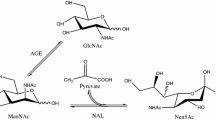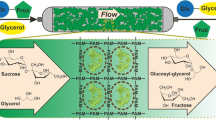Abstract
Ni2+-functionalized porous ceramic/agarose composite beads (Ni-NTA Cerose) can be used as carrier materials to immobilize enzymes harboring a metal affinity tag. Here, a 6×His-tag fusion alcohol dehydrogenase Mu-S5 and glucose dehydrogenase from Bacillus megaterium (BmGDH) were co-immobilized on Ni-NTA Cerose to construct a packed bed reactor (PBR) for the continuous synthesis of the chiral intermediate (S)-(4-chlorophenyl)-(pyridin-2-yl) methanol ((S)-CPMA) NADPH recycling, and in situ product adsorption was achieved simultaneously by assembling a D101 macroporous resin column after the PBR. Using an optimum enzyme activity ratio of 2:1 (Mu-S5: BmGDH) and hydroxypropyl-β-cyclodextrin as co-solvent, a space-time yield of 1560 g/(L·d) could be achieved in the first three days at a flow rate of 5 mL/min and substrate concentration of 10 mM. With simplified selective adsorption and extraction procedures, (S)-CPMA was obtained in 84% isolated yield.





Similar content being viewed by others
Abbreviations
- ADH:
-
Alcohol dehydrogenase
- GDH:
-
Glucose dehydrogenase
- FDH:
-
Formate dehydrogenase
- CPMK:
-
(4-Chlorophenyl)(pyridine-2-yl)ketone
- (S)-CPMA:
-
(S)-(4-Chlorophenyl)-(pyridin-2-yl) methanol
- DNPH:
-
2,4-Dinitrophenylhydrazine
- PBR:
-
Packed bed reactor
- Cerose:
-
Ceramic/agarose composite beads
References
Britton, J., Majumdar, S., & Weiss, G. A. (2018). Continuous flow biocatalysis. Chemical Society Reviews, 47(15), 5891–5918.
Adamo, A., Beingessner, R. L., Behnam, M., Chen, J., Jamison, T. F., Jensen, K. F., Monbaliu, J. M., Myerson, A. S., Revalor, E. M., Snead, D. R., Stelzer, T., Weeranoppanant, N., Wong, S. Y., & Zhang, P. (2016). Science, 352, 54–61.
Webb, D., & Jamison, T. F. (2010). Continuous flow multi-step organic synthesis. Chemical Science, 1(6), 675–680.
Cuong, N. P., Lee, W., Oh, I., Thuy, N. M., Kim, D., Park, J., & Park, K. (2016). Continuous production of pure maltodextrin from cyclodextrin using immobilized Pyrococcus furiosus thermostable amylase. Process Biochemistry, 51(2), 282–287.
Cimporescu, A., Todea, A., Badea, V., Paul, C., & Peter, F. (2016). Efficient kinetic resolution of 1,5-dihydroxy-1,2,3,4-tetrahydronaphthalene catalyzed by immobilized Burkholderia cepacia lipase in batch and continuous-flow system. Process Biochemistry, 51(12), 2076–2083.
Jia, C., Wang, H., Zhang, W., Zhang, X., & Feng, B. (2018). Efficient enzyme-selective synthesis of monolauryl mannose in a circulating fluidized bed reactor. Process Biochemistry, 66, 28–32.
de Oliveira Lopes, R., Ribeiro, J. B., Silva De Miranda, A., Vieira Da Silva, G. V., Miranda, L. S. M., Ramos Leal, I. C., & Mendonça Alves De Souza, R. O. (2014). Tetrahedron, 70, 3239–3242.
Tamborini, L., Romano, D., Pinto, A., Contente, M., Iannuzzi, M. C., Conti, P., & Molinari, F. (2013). Biotransformation with whole microbial systems in a continuous flow reactor: resolution of (RS)-flurbiprofen using Aspergillus oryzae by direct esterification with ethanol in organic solvent. Tetrahedron Letters, 54(45), 6090–6093.
Döbber, J., Gerlach, T., Offermann, H., Rother, D., & Pohl, M. (2018). Closing the gap for efficient immobilization of biocatalysts in continuous processes: HaloTag™ fusion enzymes for a continuous enzymatic cascade towards a vicinal chiral diol. Green Chemistry, 20(2), 544–552.
**ao, M., Qi, C., & Obbard, J. P. (2011). Bioenergy, 3, 293–298.
Tan, A. W., Fischbach, M., Huebner, H., Buchholz, R., Hummel, W., Daussmann, T., Wandrey, C., & Liese, A. (2006). Synthesis of enantiopure (5R)-hydroxyhexane-2-one with immobilised whole cells of Lactobacillus kefiri. Applied Microbiology and Biotechnology, 71(3), 289–293.
Thompson, M. P., Peñafiel, I., Cosgrove, S. C., & Turner, N. J. (2018). Organic Process Research and Development, 23, 9–18.
Li, F., Zheng, Y., Li, H., Chen, F., Yu, H., & Xu, J. (2019). Preparing β-blocker (R)-Nifenalol based on enantioconvergent synthesis of (R)-p-nitrophenylglycols in continuous packed bed reactor with epoxide hydrolase. Tetrahedron, 75(12), 1706–1710.
Orrego, A. H., López-Gallego, F., Espaillat, A., Cava, F. M. J., & A, G.A.A.J. (2018). ChemCatChem, 10, 3002–3011.
García-García, P., Rocha-Martin, J., Fernandez-Lorente, G., & Guisan, J. M. (2018). Enzyme and Microbial Technology, 115, 73–80.
Arana-Pena, S., Carballares, D., Morellon-Sterlling, R., Berenguer-Murcia, A., Alcantara, A. R., Rodrigues, R. C., & Fernandez-Lafuente, R. (2020). Enzyme co-immobilization: Always the biocatalyst designers’ choice…or not? Biotechnology Advances, 107584. https://doi.org/10.1016/j.biotechadv.2020.107584.
Rocha-Martín, J., Rivas, B. D. L., Muñoz, R., Guisán, J. M., & López-Gallego, F. (2012). Rational Co-Immobilization of Bi-Enzyme Cascades on Porous Supports and their Applications in Bio-Redox Reactions with In Situ Recycling of Soluble Cofactors. ChemCatChem, 4(9), 1279–1288.
Trobo-Maseda, L., Orrego, A. H., Guisan, J. M., & Rocha-Martin, J. (2020). Coimmobilization and colocalization of a glycosyltransferase and a sucrose synthase greatly improves the recycling of UDP-glucose: Glycosylation of resveratrol 3-O-β-D-glucoside. International Journal of Biological Macromolecules, 157, 510–521.
Hearon, J. Z., Sundberg, L., & MalmstrOm, B. G. (1975). Nature, 258, 598–599.
Planchestainer, M., Contente, M. L., Cassidy, J., Molinari, F., Tamborini, L., & Paradisi, F. (2017). Continuous flow biocatalysis: production and in-line purification of amines by immobilised transaminase from Halomonas elongata. Green Chemistry, 19(2), 372–375.
Liu, J., Pang, B. Q. W., Adams, J. P., Snajdrova, R., & Li, Z. (2017). Coupled Immobilized Amine Dehydrogenase and Glucose Dehydrogenase for Asymmetric Synthesis of Amines by Reductive Amination with Cofactor Recycling. ChemCatChem, 9(3), 425–431.
Vahidi, A. K., Yang, Y., Ngo, T. P. N., & Li, Z. (2015). Simple and Efficient Immobilization of Extracellular His-Tagged Enzyme Directly from Cell Culture Supernatant As Active and Recyclable Nanobiocatalyst: High-Performance Production of Biodiesel from Waste Grease. ACS Catalysis, 5(6), 3157–3161.
Yang, J., Ni, K., Wei, D., & Ren, Y. (2015). One-step purification and immobilization of his-tagged protein via Ni2+-functionalized Fe3O4@polydopamine magnetic nanoparticles. Biotechnology and Bioprocess Engineering, 20(5), 901–907.
Engelmark Cassimjee, K., Kadow, M., Wikmark, Y., Svedendahl Humble, M., Rothstein, M. L., Rothstein, D. M., & Bäckvall, J. E. (2014). A general protein purification and immobilization method on controlled porosity glass: biocatalytic applications. Chemical Communications, 50(65), 9134.
Ueda, E. K. M., Gout, P. W., & Morganti, L. (2003). Current and prospective applications of metal ion–protein binding. Journal of Chromatography. A, 988(1), 1–23.
Chou, Y., Ko, C., Chen, L. O., & Shaw, C. Y. (2015). Purification and Immobilization of the Recombinant Brassica oleracea Chlorophyllase 1 (BoCLH1) on DIAION®CR11 as Potential Biocatalyst for the Production of Chlorophyllide and Phytol. Molecules, 20(3), 3744–3757.
Böhmer, W., Knaus, T., & Mutti, F. G. (2018). Hydrogen-Borrowing Alcohol Bioamination with Coimmobilized Dehydrogenases. ChemCatChem, 10(4), 731–735.
Melchers, K., Herrmann, L., Mauch, F., Bayle, D., Heuermann, D., Weitzenegger, T., Schuhmacher, A., Sachs, G., Haas, R., Bode, G., Bensch, K., & Schäfer, K. P. (1998). Acta Physiologica Scandinavica. Supplementum, 643, 123–135.
Melchers, K., Weitzenegger, T., Buhmann, A., Steinhilber, W., Sachs, G., & Schafer, K. P. (1996). Cloning and Membrane Topology of a P type ATPase from Helicobacter pylori. The Journal of Biological Chemistry, 271(1), 446–457.
Hou, J., **, Q., Du, J., Li, Q., Yuan, Q., & Yang, J. (2014). A rapid in situ immobilization of d-amino acid oxidase based on immobilized metal affinity chromatography. Bioprocess and Biosystems Engineering, 37(5), 857–864.
Dall'Oglio, F., Contente, M. L., Conti, P., Molinari, F., Monfredi, D., Pinto, A., Romano, D., Ubiali, D., Tamborini, L., & Serra, I. (2017). Flow-based stereoselective reduction of ketones using an immobilized ketoreductase/glucose dehydrogenase mixed bed system. Catalysis Communications, 93, 29–32.
Peschke, T., Bitterwolf, P., Gallus, S., Hu, Y., Oelschlaeger, C., Willenbacher, N., Rabe, K. S., & Niemeyer, C. M. (2018). Angewandte Chemie, International Edition, 57, 17028–17032.
Fassouane, A., Laval, J. M., Moiroux, J., & Bourdillon, C. (1990). Electrochemical regeneration of NAD in a plug-flow reactor. Biotechnology and Bioengineering, 35(9), 935–939.
Ruinatscha, R., Buehler, K., & Schmid, A. (2014). Development of a high performance electrochemical cofactor regeneration module and its application to the continuous reduction of FAD. Journal of Molecular Catalysis B: Enzymatic, 103, 100–105.
Velasco-Lozano, S., Benítez-Mateos, A. I., & López-Gallego, F. (2017). Angewandte Chemie, International Edition, 56, 771–775.
Benítez-Mateos, A. I., San Sebastian, E., Ríos-Lombardía, N., Morís, F., González-Sabín, J., & López-Gallego, F. (2017). Asymmetric Reduction of Prochiral Ketones by Using Self-Sufficient Heterogeneous Biocatalysts Based on NADPH-Dependent Ketoreductases. Chemistry - A European Journal, 23(66), 16843–16852.
Zhou, J., Xu, G., Han, R., Dong, J., Zhang, W., Zhang, R., & Ni, Y. (2016). Carbonyl group-dependent high-throughput screening and enzymatic characterization of diaromatic ketone reductase. Catalysis Science & Technology, 6(16), 6320–6327.
Zhou, J., Wang, Y., Xu, G., Wu, L., Han, R., Schwaneberg, U., Rao, Y., Zhao, Y., Zhou, J., & Ni, Y. (2018). Structural Insight into Enantioselective Inversion of an Alcohol Dehydrogenase Reveals a “Polar Gate” in Stereorecognition of Diaryl Ketones. Journal of the American Chemical Society, 140(39), 12645–12654.
Ni, Y., Zhou, J., & Sun, Z. (2012). Production of a key chiral intermediate of Betahistine with a newly isolated Kluyveromyces sp. in an aqueous two-phase system. Process Biochemistry, 47(7), 1042–1048.
Gaberc-Porekar, V., & Menart, V. (2001). Perspectives of immobilized-metal affinity chromatography. Journal of Biochemical and Biophysical Methods, 49(1-3), 335–360.
Kohlmann, C., Leuchs, S., Greiner, L., & Leitnera, W. (2011). Continuous biocatalytic synthesis of (R)-2-octanol with integrated product separation. Green Chemistry, 13(6), 1430–1437.
Funding
This work was supported by the National Key R&D Program [2018YFA0901700], the National Natural Science Foundation of China [21907040, 21776112, 22077054], China Postdoctoral Science Foundation [2019 M651703], the National First-Class Discipline Program of Light Industry Technology and Engineering [LITE2018-07], and the Program of Introducing Talents of Discipline to Universities [111-2-06].
Author information
Authors and Affiliations
Contributions
Jieyu Zhou: Conceptualization, investigation, methodology, writing-original draft. Yanfei Wu: Data curation. Qingye Zhang: Data curation, formal analysis. Guochao Xu: Writing—review and editing. Ye Ni: Supervision, writing—review and editing, project administration, funding acquisition.
Corresponding author
Ethics declarations
Competing Interests
The authors declare no competing interests.
Additional information
Publisher’s Note
Springer Nature remains neutral with regard to jurisdictional claims in published maps and institutional affiliations.
Supplementary Information
ESM 1
(DOCX 200 kb)
Rights and permissions
About this article
Cite this article
Zhou, J., Wu, Y., Zhang, Q. et al. Co-immobilized Alcohol Dehydrogenase and Glucose Dehydrogenase with Resin Extraction for Continuous Production of Chiral Diaryl Alcohol. Appl Biochem Biotechnol 193, 2742–2758 (2021). https://doi.org/10.1007/s12010-021-03561-5
Received:
Accepted:
Published:
Issue Date:
DOI: https://doi.org/10.1007/s12010-021-03561-5




